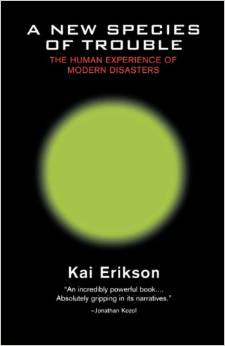Erikson, Kai. 1994. A New Species of Trouble: The Human Experience of Modern Disasters. W.W. Norton and Company.*
 Kai Erikson posits the thesis that the kinds of disasters that increasingly befall contemporary human communities are historically unprecendented. In particular, this “new species of trouble” is marked, he argues, by three characteristics: they are induced by humans and human technologies; they involve toxic contamination of bodies and environments; and they are chronic in a way that “violate[s] all the rules of plot,” esepcially the precept that a sensible plot must resolve and end.
Kai Erikson posits the thesis that the kinds of disasters that increasingly befall contemporary human communities are historically unprecendented. In particular, this “new species of trouble” is marked, he argues, by three characteristics: they are induced by humans and human technologies; they involve toxic contamination of bodies and environments; and they are chronic in a way that “violate[s] all the rules of plot,” esepcially the precept that a sensible plot must resolve and end.
The book’s structure comprises seven case studies bookended by a prologue and epilogue. The cases are remarkably disparate, yet can stand alone. Erikson’s eloquent writing and the book’s structure make it relatively straightforward to adapt inidvidual chapters for course readings, depending upon which aspects educators wish to emphasize and explore. While not all of these cases qualify as members of the “new species” of disaster, all fit within Erikson’s larger frame of disaster-as-collective-trauma, developed in earlier work, and allow him to explore the consequences of chronic collective trauma in particular.
Erikson’s 1994 description of the “new species of trouble” prefigured the catastrophe that has come to be known simply as “Fukushima.” Because these new disasters are human-induced, victims lose trust in human institutions ; due to contamination, nature itself can no longer be relied upon. Sufferers must endure a chronic period of uncertainty and profound trauma, in which they lose their ability to make sense of the universe. Erikson repeatedly notes in his cases that people exhibit a pervasive fear of invisible toxins, exceeding their fears of comparably destructive but conventional hazards.
Erikson’s book provides a crucial framework for understanding the ways that communities have experienced the trauma associated with the uncertain prospects and realities of toxic, radioactive contamination. In turn, it helps to understand how people in Fukushima Prefecture, and Japan more broadly, might apprehend radiological risk.
—Tyson Vaughan, National University of Singapore
* Editor’s Note: The initial edition of the book, also published in 1994, carried the subtitle “Explorations in Disaster, Trauma, and Community.”
![[Teach311 + COVID-19] Collective](https://blogs.ntu.edu.sg/teach311/files/2020/04/Banner.jpg)